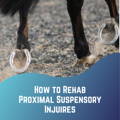Your Cart is Empty

This Is How To Rehab
Proximal Suspensory Injury
Hind limb proximal suspensory injuries are one of the top three injuries that Dr. Sherry Johnson, managing partner of Equine Sports Medicine and Rehabilitation, sees at her clinic (Tendoninjuries and the spectrum of osteoarthritis are the other two.) Here we pick her brain on how to best rehabilitate a horse with this condition—with the ultimate hope of returning to soundness, work, and competition. And, as always, Dr. Johnson recommends working alongside a veterinarian to assess and rehabilitate your horse.
The first, crucial step in managing an equine athlete with a hindlimb proximal suspensory ligament injury is to work with your veterinarian to characterize the extent and source of injury as accurately as possible. This is most commonly approached through the process of diagnostic blocking and imaging.
The advancements in MRI evaluation of this dense anatomic region in horses has really shed light on the intricacies of injury patterns. It’s also important to tease out particular features of each injury, such as: Is the hock also involved? Or, are the lower suspensory branches implicated as well?
These are all features that ultimately change the trajectory of each case’s successful management. The biggest thing I tell my owners and trainers is that each suspensory injury is unique, and each horse’s path to recovery will look different. Of all the orthopedic injuries horses get, therapeutic responses to hind suspensory injury management can vary the most.
Despite the nuances that make each case’s management different (medical management vs. surgical management, etc.), there is a general framework of useful tips and tricks to help your horse along the road to recovery.
In the early phases of injury, support—from icing, NSAIDS, compression, and physical therapy—begin at a high level and are then reduced as the horse begins to show progress in recovery. It’s all a big recipe that begins with all the support aids that are then peeled away, one by one, as I’m able to increase the physical work load.
In the beginning of the rehab process, exercise is typically very light, but it ultimately depends on the extent, severity and chronicity of injury. Hand walking, in addition to core physical therapy exercises, is commonly utilized. Strategies to activate hindlimb muscle groups to stabilize the entire pelvis are frequently incorporated. Alongside the gradual, physical work, I like to utilize icing after each workout session for pain modulation and to keep inflammation and swelling at bay.
At ESMR, we use targeted flexibility and strength training in one-on-one sessions with the horse and one of our physical therapists. Once the horse begins to improve, we’re able to increase with exercise modifiers like ground pole passes, resistance bands, introducing light weights, or increasing speed. We tweak these regimens based on the trajectory of the individual case. There are so many layers and benchmarks, and I need to see the horse pass a level in comfort before they can transition to the next phase.
There are so many thoughts and considerations that go into every single protocol decision in the rehab process. For example, I must consider if the horse is a young Thoroughbred, an older Warmblood, or a Quarter Horse reining prospect. Each athlete is different, and what their body needs to be physically prepared to do their job is quite unique. I truly believe in taking a global approach to the horse. Icing, nutrition, foot care, exercise, core physical therapy, medication—these are all part of the comprehensive package that we utilize at our clinics.
Further treatment depends at which stage the horse will go home. Some don’t go home until they’re ready to be in training or to go show and some have owners that want them back sooner. Whichever stage of recovery the horse is in, I send the horse home with specific instructions and a plan with exercises and an icing regimen.
I always recommend that my clients invest in Ice Horse suspensory wraps when rehabbing this injury because of the anatomic fit and because the Ice Horse ice packs mold to the leg to effectively deliver cold therapy. The Ice Horse wraps have the proper amount of compression and will stay cold for the long periods of time required to see benefits from icing.
Dr. Sherry Johnson, DVM, MS, Ph.D., DACVSMR, was raised in Iowa on a row crop farm, spending most of her time on the back of a horse. She attended veterinary school at Iowa State University, followed by an internship at the Equine Medical Center of Ocala (EMCO). After completing an Equine Sports Medicine & Rehabilitation residency at Colorado State University and becoming DACVSMR board-certified, she completed her Ph.D. which focused on rehabilitation modalities related to tendon healing.



